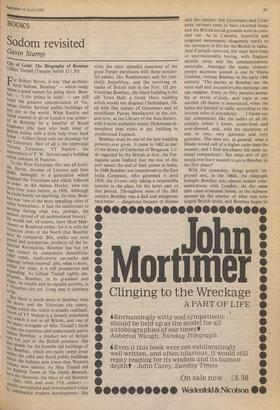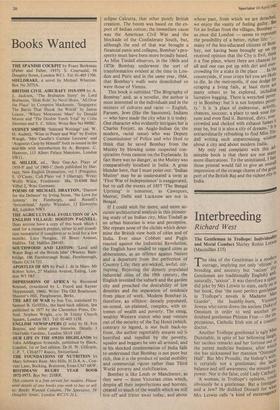BOOKS Sodom revisited
Gavin Stamp
city of Gold: The Biography of Bombay Gillian Tindall (Temple Smith £11.50) For Robert Byron, it was 'that architec- tural Sodom, Bombay' — which today seems a good reason for going there. Bom- bay — `Urbs prima in Indis' — can still boast the greatest concentration of Vic- torian Gothic Revival public buildings of any city in the world. What Ruskin and Street wanted to do to Londcn was achiev- ed in Bombay by a handful of Royal Engineers (the men who built most of British India) with a little help from back home — Gilbert Scott sent out drawings for the University. Best of all is the celebrated Victoria Terminus, 'VT Station', the Masterpiece of F. W. Stevens and a building which outdoes St Pancras. To the Post-Victorians this was all horri- b,le. Byron, devotee of Lutyens and New uelhi, belonged to a generation which desPised the Victorians and which believed order, as did Aldous Huxley, who was there four years before, in 1926. Although he could barely see anything, for him, Born- bay was 'one of the most appalling cities of either hemisphere. It had the misfortune to develop during what was, perhaps, the darkest period of all architectural history.' Ile would not, of course, have liked Man- chester or Bradford either, for it is with the Victorian cities of the North that Bombay Must be compared. But, unlike our once Proud and prosperous products of the In- dustrial Revolution, Bombay has not yet been ruined by compulsive demolition, relief roads, multi-storey car-parks and Planned 'urban renewal' and, what is more, unlike our cities, it is still prosperous and exrianding. As Gillian Tindall rightly em- phasises, Bombay, in its grandeur and eh,,.0s, its wealth and its squalid poverty, is a , Victorian city yet. Long may it continue to be But there is much more to Bombay than the docks. and the Victorian city centre, wtth'n which the visitor is usually confined. cNorth of VT Station is a densely populated 4tty which is not at all British, and one of e many strengths of Miss Tindall's book is that she examines and understands native lau Bombay: a product not of British 4'e but just of the British presence. She "bs.° pleads for the humble old buildings of Is. Bombay, which are easily swept away unlike the solid and florid public buildings . which the Indians now know that Western
now admire. As Miss Tindall did
Kentish Town in The Fields Beneath, "ere she discovers the relics of old Bombay ; 19th, 18th and even 17th century buallY surrounded and overwhelmed today ramshackle modern developments. She
visits the once splendid mansions of the great Parsee merchants with those wonder- ful names, like Readymoney and Sir Jam- shetji Jeejeebhoy, and the surviving re- mains of British rule in the Fort. Of pre- Victorian Bombay, the finest building is the old Town Hall: a Greek Doric building which would not disgrace Cheltenham, fill- ed with fine statues of Governors and of munificent Parsee benefactors to the city, and now, as the Library of the Asia Society, with a more authentic musty Dickensian at- mosphere than exists in any building in modernised England.
Bombay must be one of the best wedding presents ever given. It came in 1662 as part of the dowry of Catherine of Braganza. Lit- tle regarded by the British at first, the Por- tuguese soon realised that the loss of this port meant the end of their power in India. In 1668 Bombay was transferred to the East India Company, who governed it until 1858, the Crown only taking a responsible interest in the place for the latter part of that period. Throughout most of the 18th century Bombay was a dull and dangerous backwater — dangerous because of disease and the climate: few Governors and Com- pany servants seem to have returned home and the British burial grounds were in cons- tant use. As in Calcutta, beautiful and poignant monuments eloquently testify to the shortness of life for the British in India. And if people survived, life must have been so unconscionably boring, with England months away and the communications uncertain. Amongst the many contem- porary accounts quoted is one by Maria Graham, visiting Bombay in the early 19th century: 'The parties at Bombay are the most dull and uncomfortable meetings one can imagine. Forty or fifty persons assem- ble at seven o'clock, and stare at one another till dinner is announced, when the ladies are handed to table, according to the strictest rules of precedency .. . I found our fair companions like the ladies of all the country towns I know, under-bred and over-dressed, and, with the exception of one or two, very ignorant and very grossiere. The men are, in general, what a Hindu would call of a higher caste than the women; and I find merchants the most ra- tional companions'. But what sort of girl would ever have wanted to go to Bombay in the first place?
With the steamship, things greatly im- proved and, in the 1860s, the telegraph brought Bombay into almost instant com- munications with London. At the same time came economic boom, as the railways opened up the interior of what was now largely British India, and Bombay began to
eclipse Calcutta, that other purely British creation. The boom was based on the ex- port of Indian cotton; the immediate cause was the American Civil War and the blockade of the Confederate South, but, although the end of that war brought a financial panic and collapse, Bombay's pro- sperity must have been more broadly based.
As Miss Tindall observes, in the 1860s and 1870s Bombay underwent the sort of transformation evident at the time in Lon- don and Paris and in the same year, 1864, that Bombay's walls were demolished so were those of Vienna.
This book is subtitled 'The Biography of Bombay' and, as a novelist, the author is most interested in the individuals and in the mixture of cultures and races — English, Parsees, Jews (like the Sassoons), Indians — who have made the city what it is today. One character who evidently intrigues her is Charles Forjett, an Anglo-Indian (in the modern, racial sense) who was Deputy Commissioner of Police and who liked to think that he saved Bombay from the Mutiny by blowing some suspected con- spirators from cannon on the Esplanade. In fact there was no danger, as the Mutiny was comparatively localised in India. A great blunder here, that I must point out: 'Indian Mutiny' may be as understated a term as 'First War of Independence' is exaggerated, but to call the events. of 1857 'The Bengal Uprising' is nonsense, as Cawnpore, Meerut, Delhi and Lucknow are not in Bengal.
If I could wish for more, and more ac- curate architectural analysis in this pioneer- ing study of an Indian city, Miss Tindall as an urban historian is wise and perceptive. She repeats none of the clichés which deter- mine the British view both of cities and of India. Ever since Cobbett and Pugin reacted against the Industrial Revolution, the English have tended to regard cities as abberations, as an offence against Nature and a departure from the perfection of Country Life; they are-wicked, awful, cor- rupting. Rejecting the densely populated industrial cities of the 19th century, the English invented the suburb and the garden city and preached the desirability of low densities and the separation of residence from place of work. Modern Bombay is, therefore, an offence: densely populated, un-zoned, un-planned, complex, with ex- tremes of wealth and poverty. The smug, wealthy Western visitor who may venture out of the security of the Taj Hotel (which, contrary to legend, is not built back-to- front, the author regrettably assures us) is horrified and repelled by the poverty, squalor and beggars he sees all around, and in his shocked condemnation of India fails to understand that Bombay is not poor but rich, that it is the product of social mobility and commercial vigour rather than Third World poverty and stultification.
Bombay is like Leeds or Manchester, as they were — those Victorian cities which, despite all their imperfections and horrors, created so much of the wealth which we still live off and fritter away today, and about whose past, from which we are detached, we enjoy the vanity of feeling guilty. But for an Indian from the villages, Bombay — as once did London — seems to represent the possibility of a better, richer life: `. • • many of the less-educated citizens of Boni- bay, not having been brought up on the received opinion that the City is Evil, dunk it a fine place, where there are chances for all and one can put up with dirt and over- crowding for a stake in the place ... In the countryside, if your crops fail you are like]) to die. In the metropolis, if one dodge for scraping a living fails, at least there are many others to be explored, including lucrative begging. There is wretched pover- ty in Bombay: but it is not hopeless pover- ty.' It is 'a place of endeavour, activity, chances, succour, a place to seek your for- tune and even find it. Battered, dirty, over crowded and choked with exhaust fumes it may be, but it is also a city of dreams.' It is extraordinarily refreshing to find Miss Tin- dall writing such unpatronising wisdom about a city and about modern India. , My only real complaint with this ao" mirable book is that there are not many more illustrations. To the uninitiated, I fear, those printed would fail to give an overall impression of the strange charm of the great port of the British Raj and the richest city to India.



































 Previous page
Previous page